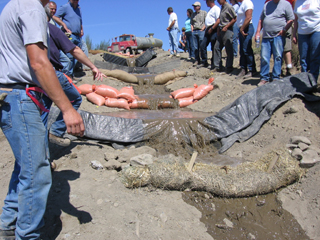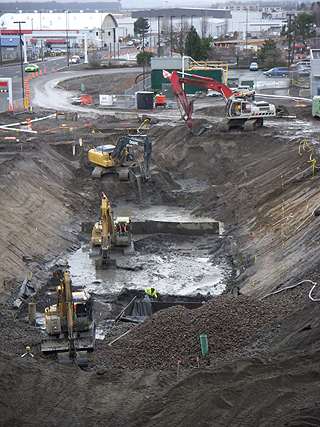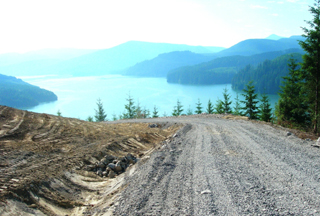
Surveys
Awards
DJC.COM
March 27, 2008
It pays to have a stormwater permit strategy
Laness Environmental Advanced Design

Lane
|
Surprise! Since November 2006, all construction projects in the state over one acre in size are required to obtain a National Pollution Discharge Elimination System (NPDES) permit through the state Department of Ecology.
This shouldn’t have been news to the seasoned contractor since the Environmental Protection Agency has been steadily working on this plan since about 1977. But, for those in hard hats caught off guard anyway, the consequential knee jerk reaction has sent thousands of permanent hires in the construction field streaming through CESCL courses over the last year. This course helps make sense out of the helpful agency acronyms like the easily remembered NPDES and its groupies — SWPPP, BMP, DMR and CESCL. These are the Storm Water Pollution Prevention Plan, Best Management Practices, Discharge Monitoring Report and the Certified Erosion Sediment Control Lead, respectively.

Hard hats undergoing CESCL training learn how different barriers slow water down on a slope. |
Of course, the list wouldn’t be complete without the prominent State Environmental Policy Act (SEPA) checklist and the much-coveted Determination of Non-Significance (DNS), but what list is.
Although all this knee jerking got the industry limping in the right direction, it doesn’t solve the big problems. It certainly helps with the little problems, though, like getting the hard hats to think pro-actively. The old saying, “We’ve always done it this way,” isn’t going to fly anymore.
Managing the paper trail
The number of CESCLs you have on your job site is directly related to the amount of peer pressure that will be exerted when the BMPs are selected, placed and maintained. Therefore logic would assume that a heard of CESCLs would be some of the best insurance against the recent rise in Ecology construction stormwater fines. Though most of the reported fines have not been as high as the $160,000 whopper slammed on Circle C Rock Products of Ridgefield in June 2007 for “significant and continuous water quality violations,” it couldn’t hurt to have a few extra cowboys watching out to round up those free-spirited mud puddles. Could it?
Strategically, there are two questions that need to be addressed: Who should file the NPDES application and how is the paper trail going to be managed?
In August, the developers of Swiss Meadows in Montesano were fined $14,000 after blatantly failing to apply for the construction stormwater NPDES permit. OK, so it is clearly cheaper to obtain a permit. But, in their defense, maybe they thought someone else had applied for it. Someone like the engineering firm or the general contractor could have done it. Heck, Ecology doesn’t care who fills out the paperwork, as long as it gets done.
My advice is to seek out a permit specialist from the beginning. It’s more than just filling out an application. There is a public notice process, a SEPA checklist to be routed through government agencies for DNS or mitigated DNS approval, and there is a lengthy site-specific SWPPP document to be prepared. This is not a job for a hard hat; use a professional.
Get a responsible CESCL

This sediment pond, built for a large development project, collects runoff and allows silt/sand particles to drop out of suspension over time. The resulting clean water is released into a nearby creek. |
Now that you have your permit specialist, there is one more very important part to the NPDES permit. Selecting one lead CESCL to oversee the project from start to finish will save you money.
Overestimating the ability of hard hats to keep the paperwork straight as the permit is reassigned through the multitudes of appointed CESCLs using the “transfer of liability” technique is all too common. Do not expect as one stage of development is completed, say excavation, that the permit will be seamlessly transferred from the excavation CESCL to the next stage’s CESCL. Will the new CESCL be able to read all the scribbled notes left in the SWPPP by the previous CESCL? Did the last guy file the DMR for this month? Failure to update the SWPPP is a citable offense. Failure to maintain DMRs and then promptly mail them off is one of the quickest ways to get a visit from your friendly neighborhood Ecology enforcement officer.
Having just one responsible CESCL will ensure that this process doesn’t get left in the mud.
Watch out for lawsuits
I’m not a big fan of scare tactics, but if this works for you, great. It’s time to mention third-party lawsuits.
What is a third party lawsuit? Well, it’s like a law that says the crazy cat lady that lives next door to your development is allowed to buy a turbidity meter off Home Shopping Network and take you to the cleaners because she doesn’t want her kitties to drink the muddy water that runs down the curb from your project.
This is a pretty big deal. A significant number of citizen lawsuits have already resulted in seven-figure civil penalties.
It’s no mistake. The Clean Water Act intentionally placed the big-brother incentive into the act as an enforcement aid. This alternative measure allows for any citizen and/or activist groups to benefit financially from sloppy construction sites. With rewards of $27,500 per day of violation, plus attorney’s fees, watchdog coalitions such as Water Watch, Water Keepers and even the Gifford Pinchot Task Force have been quick to take junkyard-dog-sized bites out of non-compliant developers.
BMPs can save money

This rural 15 percent graded road with check dams is perfect, but the side slope’s cat tracks are disastrous. The horizontal cat tracks promote rivulets and erosion. Vertically walked tracks would have slowed water down more effectively. |
Few people embrace change. Most people associate change with expense. Change is inevitable but it doesn’t have to cost more. Many of the BMP techniques, if properly installed and maintained, will actually save your site time and money. It’s important to incorporate the appropriate BMPs to your site plan. And then assign a knowledgeable, paper-trained CESCL to oversee the project from excavation to landscaping to avoid the transfer-of-liability pitfalls.
If I can make one more helpful recommendation, it would be to post signs on your site with your CESCL’s phone number on it. Have the sign read something like: “For complaints about stormwater issues on this site, please call (888) 555-1212.” It’s better to have them call your CESCL, than Ecology, or worse.
Kimberly Lane owns and operates Laness Environmental Advanced Design in Vancouver. Lane spent eight years as a federal officer enforcing land-use laws in Southern California. She holds a bachelor’s degree in resource policy from Oregon State University.
Other Stories:
- Construction training is good for your bottom line
- How to take over a construction project
- Keep buildings in shape with facility condition indexing
- Top 10 tax tips for contractors and developers
- Is your insurance giving you a bad wrap?
- UW builds its construction management program
- Watch out for changing immigration laws
- Are your windows really Energy Stars?
- The shocking state of our national infrastructure
- Partner up for successful projects
Copyright ©2009 Seattle Daily Journal and DJC.COM.
Comments? Questions? Contact us.